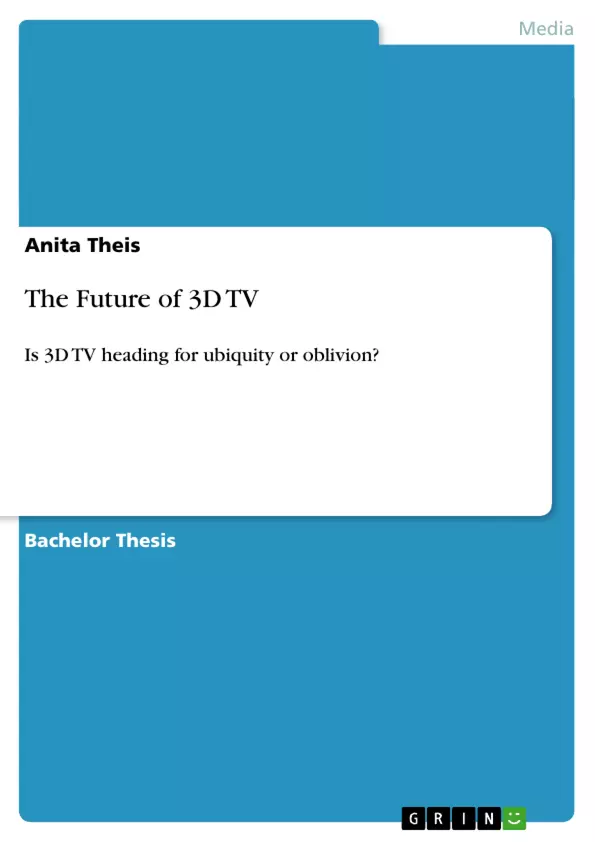This research paper answers the question of whether 3D TV will become a new trend or if it is a hype that will eventually fail to establish itself.
The paper is divided into a market research and a target group research. Both deal with the situation within the United States as the US has one of the highest market shares in 3D globally.
3D TV was introduced in 2010 and within that year the 3D TV sales made out 4% (3.2mio) of all TV sales. Within the US, 3% of the households purchased a 3D TV so far. According to E. Rogers’ book “Diffusion of Innovation” whose theory is used as a guideline throughout the whole research paper, those 3% make out the category of innovators.
The 3D TV technology has to face economic, sociological and technological challenges. Those challenges as well as the trends and developments influence the adoption of the technology. Those influencing aspects can be grouped into five categories: relative advantage, compatibility, complexibility, observability and trialability.
The research determines how the different aspects concerning the 3D technology influence these categories in order to come up with possible forecast of 3D TV.
The relative advantage is mainly influenced by the target group’s perception of 3D TV. While 3D TV aims to add an experience domain to the traditional experience of 2D TV, this is not especially valued among the target group. The price of 3D TV sets however does play a significant role – many consider the prices of 3D as too high. However the experience teaches that the prices are likely to decrease due to the price setting strategy called “price-skimming”.
The most important factor concerning compatibility is the unfavorable launch-date of 3D TVs in the US. On the positive side, the increased production of 3D content that fits the target group’s profile makes 3D perfectly compatible with the target group’s values.
Though 3D TV is a rather complex technology, especially in this time now that there is new technology developed all the time, creating an information jungle.
In the end and compared with the target group research, it seems as if the 3D TV technology will actually make it and become a new trend.
Inhaltsverzeichnis (Table of Contents)
- Executive Summary
- Management Samenvatting
- Preamble
Zielsetzung und Themenschwerpunkte (Objectives and Key Themes)
This research paper explores the future of 3D TV, examining its potential for widespread adoption or its possible decline. The primary focus is on the US market, given its significant global 3D market share. The research combines market analysis with an examination of the target group's perception and adoption behavior.- The adoption of 3D TV technology and its relation to the "Diffusion of Innovation" theory.
- Influence of economic, sociological, and technological factors on 3D TV adoption.
- The role of relative advantage, compatibility, complexity, observability, and trialability in influencing 3D TV adoption.
- Target group perception and its impact on the perceived relative advantage of 3D TV.
- The impact of factors like price, the need for glasses, and the digital revolution on 3D TV compatibility.
Zusammenfassung der Kapitel (Chapter Summaries)
- Executive Summary: This section provides a concise overview of the research paper, highlighting the central question of 3D TV's future and the methodology employed. It emphasizes the paper's division into market research and target group research, both focused on the US market. The section introduces the concept of the "Diffusion of Innovation" theory, which is used as a framework throughout the research.
- Management Samenvatting: This section presents a summary of the research in Dutch, mirroring the key points and themes explored in the Executive Summary. It emphasizes the relevance of 3D TV's potential for becoming a trend and the factors influencing its adoption. This section provides a Dutch perspective on the research findings.
- Preamble: This section introduces the author's background and personal experiences that led to the choice of 3D TV as the subject of the research. It highlights the author's involvement in a documentary production for Discovery Channel & 3net and emphasizes the impact of this experience on their decision to focus on 3D TV in their dissertation. This section concludes with acknowledgements and expressions of gratitude to individuals who have supported the author during their studies and the writing process.
Schlüsselwörter (Keywords)
This dissertation delves into the dynamics of the 3D TV market, focusing on the US as a key market and analyzing consumer behavior using Rogers' "Diffusion of Innovation" theory. The research examines the adoption of 3D TV technology, its potential for mainstream acceptance, and the influencing factors such as relative advantage, compatibility, complexity, observability, and trialability. The study also explores the perceptions and attitudes of the target audience toward 3D TV.- Citar trabajo
- Anita Theis (Autor), 2011, The Future of 3D TV , Múnich, GRIN Verlag, https://www.grin.com/document/192383



